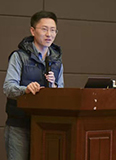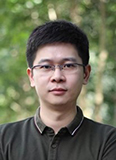

Prof. Yang Wang
Faculty of Geography, Yunnan Normal University, China
Yang Wang is a professor in the Department of Faculty of Geography, Yunnan Normal University. He graduated from the Institute of Geographic Sciences and Natural Resources Research, Chinese Academy of Sciences with a Ph.D. (major in human geography). His research interests are urban geography and geographic data applications. He has published 65 academic papers as the first author or corresponding author, including 12 SSCI/SCI papers, and 4 academic books published independently or edited by him. A single paper has been cited for 438 times. He presided over 2 projects of the National Natural Science Foundation of China. As the first inventor, he authorized 2 invention patents and 7 utility model patents. He has obtained 9 software copyrights, one of which won the title of "Guangdong High-tech Product". His related academic achievements have won academic awards such as the "First (2016) Most Influential Chinese Geographical Journal Excellent Paper Award" and "The Second Prize of the 2020 Guangdong Provincial Natural Science Award". He is also a member of the youth editorial boards of the journals of “Economic Geography” and “Tropical Geography”.

Prof. Yi Luo
Faculty of Geography, Yunnan Normal University, China
Luo Yi, male, born in October 1986, Han Nationality, is currently the deputy director, professor and doctoral supervisor of Engineering Research Center of Western Resources and Environment Geographic Information Technology, Ministry of Education, Faculty of Geography, Yunnan Normal University, member of Theory and Method Working Committee of China Geographic Information Industry Association. He has presided over and participated in 10 projects including major basic Research Program (973 Program), National High Technology Development Research Program (863 Program), National Science and Technology Support Program, national Key Science and technology Water Sub-project, and National Natural Science Foundation of China. Published more than 50 academic papers in Chinese and English as the first or corresponding author, including more than 30 SCI indexed papers, 3 ESI highly cited papers, with a total of more than 800 citations. Published in Water Resources Research, Water Research, Land Degradation and Development, Journal of Hydrology, Environmental 7 invention patents have been granted on famous publications such as Pollution, Journal of Environmental Management, Cities, Environmental Science, Journal of Scientific Instrument, Transactions of Agricultural Engineering and Acta Ecologica Sinica. He has won the second prize of National Teaching Achievement Award, GIS Innovation Figure in Chinese Universities, and Outstanding Reviewer of Science of the Total Environment.

Prof. Quazi K. Hassan
University of Calgary, Canada
Dr. Quazi K. Hassan is a Professor of Earth Observation in the Department of Geomatics Engineering, and Centre for Environmental Engineering Research and Education (CEERE) at the University of Calgary. His research interests include: (i) application of remote sensing in forecasting and monitoring of natural hazards/disasters, such as forest fire, drought, and flooding; (ii) use of remote sensing and GIS techniques in understanding the dynamics of natural resources, such as forestry, agriculture, and water; and (iii) integration of remote sensing, GIS, and modelling techniques in addressing issues related to energy and environment.
Speech Title: Remote sensing based quantification of urban warming
Abstract: At the Earth Observation for the Environment Laboratory in The University of Calgary, we conduct research in comprehending urban warming using remote sensing imagery. In the scope of this presentation, the plan is to discuss about the influence of: (i) urban landsccape’s composition and configuration on land surface temperature, and (ii) urban expansion, population, precipitation, and large-scale atmospheric oscillations including Sea Surface Temperature (SST), Pacific North America (PNA), Pacific Decadal Oscillation (PDO), and Arctic Oscillation (AO), on urban warming. We believe that these would be critical for ensuirng sustainable development of urban areas across the world.

Prof. Ye Wei
School of Geographical Sciences, Northeast Normal University, China
Ye Wei (1983-), born in Lishu, Jilin, is a professor and doctoral supervisor. His main research fields are urban and regional planning and GIS applications. He is currently the Assistant Dean of the School of Geographical Sciences and the Deputy Dean of the Jilin Provincial Research Institute for Natural Resources. He has published more than 50 papers in well-known domestic and foreign journals such as Landscape and Urban Planning, Cities, Applied Geography, and Acta Geographical Sinica. He has won the first prize of the Changchun Social Science Outstanding Achievement Award and the second prize of the Jilin Province Natural Science Academic Achievement Award, and his papers have twice been rated as the top academic paper (F5000) of China’s high-quality scientific and technological journals. He is currently a member of the Reviewer Board of Remote Sensing Magazine. He has served as a reviewer for more than 30 domestic and foreign academic journals such as Cities, Applied Geography, Environment and Planning B, Journal of Transport Geography, and Acta Geographical Sinica. In 2020, he was awarded the Excellent Reviewer of Chinese Geographical Science Award. In 2021, he won the Outstanding Reviewer Award for “Geographical Research”. Currently, he has presided over a general project for the National Natural Science Foundation of China, and completed a youth project for the National Natural Science Foundation of China and many other projects. His academic part-time jobs include the member of the Population Geography Professional Committee of the Geographical Society of China, deputy secretary-general of the Sustainable Development Committee of the Old Industrial Base of the Regional Science Association of China, member of the Academic Steering Committee of the Geographical Postgraduate Union of China, director of the Geographical Society of Jilin Province, an expert from the expert database of the Jilin Department of Natural Resources, an expert from the expert database of the Jilin Provincial Department of Science and Technology, an expert from the expert database of the Jilin Provincial Department of Human Resources and Social Security, etc.
Speech Title: Structural Resilience Evolution of Global Oil and Gas Resource Trade Network
Abstract: The security and stability of the oil and gas resource trade network are crucial to national energy security and support social and economic development. This paper analyzes the evolution of the global oil and gas resource trade network structural resilience in 2010, 2015, and 2020 and establishes a network resilience evaluation framework according to the network structure, simulated attacks and identified chokepoints to make an integrated analysis of the structural resilience of the global oil and gas resource trade network. The results are as follows: The links of global oil trade network presents a gradually shrinking trend, and the natural gas trade network presents a trend of close connection first and then reduced connection. In terms of network density, network centrality, network connectivity and network size, the structural resilience of the oil and gas resource trade network displays a gradually shrinking trend, and the natural gas trade network is superior to the oil trade network. With regard to the invulnerability and recovery, the resilience of the oil trade network is superior to the natural gas trade network. In simulated attacks, the oil trade network reveals a higher resilience towards intentional attacks, and the natural gas trade network shows a higher resilience towards random attacks. The Strait of Hormuz and the Strait of Malacca are extremely important chokepoints in the oil and gas trade network. The results are able to provide reference and decision-making support for route design, optimization and lay the foundation for establishing a secure maritime transport system for resources.

Prof. Kang Wu
Beijing Key Labortory of Megaregions Sustainable Development Modelling, Capital University of Economics and Business, China
Prof. Wu's research interests include urban economic geography and spatial planning. His most recent research focus on polycentric city regions and urban networks, urban big data analysis, and the sustainable development of shrinking cities in China. His ongoing research is to understand the urban growth and urban shrinkage from a network perspective, especially to reveal the mechanism of urban growth and shrinkage based on the framework of tele-coupling and local coupling by using multi-source data. His research also simulates the urban growth and shrinkage according to scenario analysis and puts forward the urban sustainable mode and strategy of urban policy. His research findings in terms of shrinking cities in China has been accepted by the Central Government, and his policy suggestions has been incorporated in the “Key Tasks on the New- type Urbanization Construction” issued by the National Development and Reform Commission in 2019 and 2020.
Speech Title: Simulating Block-Level Urban Expansion for National Wide Cities
Abstract: Large-scale models are generally associated with large spatial modelling units, for example, counties or super grids (several to dozens of km2). Few applied urban models can achieve a large spatial coverage with irregular spatial units due to data availability and computation load. The framework of automatic identification and characterization of blocks developed by Liu and Long (2016) makes such an ideal model possible by establishing the existing urban blocks using road networks and points of interest for very large areas (e.g., a country or a continent). In this study, we develop a mega-vector-blocks cellular automata model (MVB-CA) to simulate urban expansion at the block level for 654 Chinese cities. The existing urban blocks in 2012 were used for initiating the MVB-CA and are generated using multi-levelled road networks and ubiquitous points of interest. We then simulate block-based urban expansion of all the cities from 2012 to 2017. The national spatial development strategies of China are discussed extensively by academia and policy makers, while the baseline scenario and other simulated urban expansion scenarios have been tested and compared horizontally. As one of the first block-based urban expansion models at a national scale, its academic contributions, practical applications, and potential biases are also discussed in this paper. The developed MVB-CA using general approaches is also applicable for other counties.

Prof. Yongxian Su
Guangzhou Institute of Geography, Guangdong Academy of Sciences, China
Yongxian Su, female, is a researcher, Ph.D. of the University of Chinese Academy of Sciences, post-doctoral/visiting scholar of the French Laboratory for Climate and Environmental Change, and master’s supervisor. She serves as the candidate for the China-France Outstanding Youth Program of the Ministry of Science and Technology, deputy of the Guangdong-Hong Kong-Macao Greater Bay Area Urban Agglomeration Ecosystem Monitoring Research Station Webmaster, and member of the Youth Promotion Association of Guangdong Academy of Sciences. She is mainly dedicated to global climate change and forest ecosystem services, as well as research on urban heat islands and low-carbon cities. In recent years, she has independently presided over 11 scientific research projects at or above the provincial and ministerial level, including the General and Youth Fund of the National Natural Science Foundation of China, the Natural Science Foundation of Guangdong Province, and the Foreign Cooperation and Exchange Project of the Ministry of Science and Technology. She published more than 70 scientific papers in The Innovation (Live IF=28), Environ. Int. (IF=10), Remote Sens. Enviro. (IF=10), Renew. Sust. Energ. Rev. (IF=14), Agric. For. Meteorol (3), J. Hydrol., Int. J. Appl. Earth. Obs. Geoinf. and other journals, of which there are 20 papers SCI SCI I/II as the first/corresponding author, with 3005 total citations for the scientific and technical papers, a maximum of 223 citations for a single paper, and an H-index of 22. She authorized 10 national invention patents. Her research results have won 10 Guangdong Science and Technology Progress Awards and Industry Awards, including the first prize of Guangdong Province Natural Science Award, the second prize of Guangdong Province Science and Technology Progress Award, the first prize of National Forestry Excellent Engineering Consulting Achievement Award, and the second prize of National Excellent Engineering Consulting Achievement Award, Guangdong Province Youth Geography Science and Technology Award, two third prizes of Guangdong Province Excellent Urban and Rural Planning and Design Award, etc. She was invited to serve as the young editorial board member of “The Innovation” and “Remote Sensing Technology and Application”, as well as the reviewer of more than ten domestic and foreign top journals such as Nature sub-journals. She is positioned as a member of the Urban and Rural Ecology Special Committee and Ecosystem Monitoring and Evaluation Special Committee of the “Guangdong Land and Space Ecological Restoration Association” of the Department of Natural Resources of Guangdong Province.
Speech Title: Regional Scale Coupling Between Climate and Forest Phenology and Their Hydrothermal Effects
Abstract: Climate warming is increasingly affecting ecological processes and biodiversity, with profound implications for ecosystem function and human well-being. As the main surface type of terrestrial ecosystem, forest growth, especially the phenological process of forest canopy structure, is not only directly affected by climate change, but also plays a key role in regional hydrothermal carbon and biological processes by absorbing CO2 and changing the hydrothermal interaction process with the atmosphere. Therefore, forest canopy is an important bridge between climate change and regional function. We using field observation and remote sensing data and model simulation method, focus on climate change and regional scale forest ecosystem the response and feedback of the series research, found that the climate of canopy structure (phonological process) control law and the spatial distribution pattern, illustrates the coupling mechanism between climate and canopy phenology; A forest microclimate assessment model based on vertical energy process was established, and the thresholds and latitude patterns of key structural parameters controlling forest increase and cooling were defined. Develop biophysical mechanisms for coupling forest hydrothermal effects and reveal thresholds for key climate parameters that weigh forest cooling and water resource effects.

Prof. Roman Shults
Department of Forensic Experts in Transportation / Faculty of Transportation Sciences, Czech Technical University in Prague
Editor-in-Chief Engineering Geodesy, the journal published by Kyiv National University of Civil Engineering and Architecture, Ukraine, (2015-2020).
Editorial Board Member for Journal of Environmental Science and Engineering Technology, World Journal of Geomatics and Geosciences, Bulletin of SGUGiT, Russia (2014-2020)
Reviewer Board Member for “Remote Sensing”, the journal published by MDPI
Reviewer Journals Remote Sensing, International Journal of Applied Earth Observation and Geoinformation, ISPRS International Journal of Geo-Information, Applied Geomatics, Drones, Geodesy and Cartography, Applied Geodesy, Buildings, Sensors, Applied Sciences, Heritage.
Speech Title: Urban Landslides: Complex Approach to Observation Methods and Monitoring Results Analysis
Abstract: Landslides in urban regions are dangerous and unpredictable phenomena. Typically, the landslides in urban areas are complex objects that comprise the landslides themselves, engineering structures on them, and systems of retaining walls. The retaining walls are the most common way to protect buildings and infrastructure in large cities. These walls restrain the landslides' movements, save the structures on the landslides, and protect surrounding facilities and engineering infrastructure. Insofar as the retaining walls undergo extremely high pressure from the landslide's body, complex monitoring is an essential and responsible issue. Thus, the monitoring technology should include various geospatial methods to detect spatial displacements of the landslides, structures, and retaining walls. Obviously, such a technology cannot be based on one observation method. The aim of the presented research is twofold. The first is to suggest and develop a complex urban landslide monitoring approach that embraces different observation methods and their integration. The second is monitoring results analysis. That aim is more complicated as long as it needs to draw on the miscellaneous math models and algorithms. The monitoring results have to be analyzed with special attention due to the unpredictable nature of landslides. The considerable number of factors, e.g., environmental loads, transport effect, construction works, etc., makes the analysis complex and needs different methods. The complex approach to monitoring results analysis comprises statistical and structural mechanics methods. The suggested approach starts with a statistical analysis of observations. For processing, it was recommended to use the method of analysis of variance (ANOVA). Different factors and their relationship were investigated. The changes of displacements depending on the observation epoch were studied by one-factor ANOVA. One-factor ANOVA allowed defining that the deformation process has different dynamics for different retaining walls. The relationship between epoch and retaining walls placement was determined using two-factor ANOVA. Method three-factor ANOVA allowed defining the liaison between the locations of deformation targets and displacement values. The results of the ANOVA analysis gave a clear picture of the deformation process. However, some factors remained unaccounted for. Among those factors, the temperature variation of the retaining walls is significant. Therefore, this factor had to be eliminated from observation results before creating prediction models. The methods of structural mechanics were applied to manage the issue with the temperature variation. The simulation of the retaining walls showed the additional displacements, up to 5 mm due to temperature variation. These additional displacements were ruled out from measurements results before further analysis. The next stage of the complex analysis was about the determination of regions with uniform displacements. Another statistical procedure known as cluster analysis was applied to figure out these regions. Cluster analysis allowed identifying the regions for which the same prediction models can be used. The final step was the creation of prediction models for regions with uniform displacements. The modern algorithm known as the group method of data handling (GMDH) was examined. The method allows accounting for various factors in its model. Finally, the prediction model that accounts for displacements values, targets position, environmental effect, and observation accuracy was constructed. The considered above complex approach turned out highly efficient and allowed avoiding the wrong decision during landslides monitoring and carrying the protection measures.

Assoc Prof. Guangdong Li
Institute of Geographic Sciences and Natural Resources Research, Chinese Academy of Sciences
Dr. Li received his Master's degree in human geography from Southwest University of China in 2011 and his doctor's degree in human geography from University of Chinese Academy of Sciences in 2014. He has focused on research on urban space evolution and its varying ecological effects. To address the question regarding how to coordinate the relationship between urban space and ecosystem, the applicant has (a) established a theoretical framework for coordination and optimization of multi-scale urban space territorial system, (b) revealed the multi-scale linkages and feedback transmission mechanisms of urban space evolution, (c) analyzed the nonlinear effects of urban space evolution on the ecosystem, and (d) put forward a sustainable development pattern of coordinated multi-scale urban space and ecosystem. He has published 72 papers, including 37 SCI/SSCI papers, and 3 ESI hot and highly cited papers, with a total of 2,022 SCI citations. He was selected into the Young Talents Program of the Chinese Academy of Sciences. He has won the first prize of Science and Technology Progress Award of the Ministry of Education (7/15) and the Outstanding Prize for excellent papers on urban geography.
Speech Title: Global impacts of future urban expansion on terrestrial biodiversity
Abstract: Rapid urban expansion has profound impacts on global biodiversity through habitat conversion, degradation, fragmentation, and species extinction. However, how future urban expansion will affect global biodiversity needs to be better understood. We contribute to filling this knowledge gap by combining spatially explicit projections of urban expansion under shared socioeconomic pathways (SSPs) with datasets on habitat and terrestrial biodiversity (amphibians, mammals, and birds). Overall, future urban expansion will lead to 11–33 million hectares of natural habitat loss by 2100 under the SSP scenarios and will disproportionately cause large natural habitat fragmentation. The urban expansion within the current key biodiversity priority areas is projected to be higher (e.g., 37–44% higher in the WWF’s Global 200) than the global average. Moreover, the urban land conversion will reduce local within-site species richness by 34% and species abundance by 52% per 1 km grid cell, and 7–9 species may be lost per 10 km cell. Our study suggests an urgent need to develop a sustainable urban development pathway to balance urban expansion and biodiversity conservation.

Assoc Prof. Shaojian Wang
Sun Yat-sen University, China
Shaojian Wang is an associate professor of urban geography at Sun Yat-sen University. His current research mainly uses GIS and remote sensing technology to reveal the realization path of carbon neutrality. He used GIS and remote sensing technology to reveal the spatial distribution of energy resources, energy transition and energy policies, and land use carbon sinks. He specializes in urban planning, energy economics, scenario analysis on environmental impacts and resources management and their applications in both developed and developing countries. He has been actively serving Natural Science Foundation of China, China National Governments, local governments and private companies. Shaojian has published more than 100 articles, including high-quality journals, such as Nature Sustainability, Nature Communications and Annals of AAG.

Assoc Prof. Yihan Zhang
School of Culture Tourism and Geography, Guangdong University of Finance and Economics, China
Yihan Zhang obtained his Ph.D degree in Sun Yat-sen University and now is an associate professor and master supervisor in Guangdong University of Finance and Economics. He mainly engaged in land use change, geographic simulation and data assimilation. With the support of projects (such as the National Natural Science Foundation of China, Natural Science Foundation of Guangdong Province, Innovation project of Guangdong Provincial Department of Education), He has published more than 30 papers in Science China Earth Sciences, International Journal of Geographical Information Science, Journal of Remote Sensing and Journal of Surveying and Mapping. He is selected as candidate of "Thousands and Tens of Talents Training Project" of Guangdong Province. He also won outstanding paper in 17th National Academic Symposium of Young Geographic Workers Forum, excellent teaching quality award, outstanding undergraduate mentor and excellent academic mentor. He and his students also obtain excellent results in National GIS Skills Competition, National University GIS Forum in Innovation and Entrepreneurship Competition, Challenge Cups of National and Provincial organization.

Assoc Prof. Yilun Liu
School of Public Administration, South China Agricultural University, China
Dr. Yilun LIU is an associate professor of Land resource management at the South China Agricultural University. His research integrates remote sensing, geospatial data, and computational methods for the natural resource monitoring, the natural resources and environmental management policies evaluation, urban renewal decision making supporting, and the land use optimal planning. His works received grants from the National Natural Science Foundation of China and Ministry of Natural Resources of China.
Speech Title: Spatial governance of street vendors based on social sensing and GeoAI.
Abstract: Eviction and formalization policies are widely joint used to govern street vendors in modern cities. However, the formalization schemes are at risk of failure due to they fail to respect the logic of street vending economic processes. Aiming at optimizing the geographical boundary between eviction and formalization policies, we present a model to delineate the formalization zones. The model first studies the spatial heterogeneity of location preferences of the street vendors based on city-scale detection data. Then a spatial optimization model was applied to seek an optimal formalization zoning scheme, taking into account the goals of location preferences, exclusive preferences, and administration cost. The case study results show that the sort and contribution of the influencing factors of the street vending location are different between the city core areas and peripheral areas. By introducing the social sensing data source and GeoAI technique, the presented model can portray the location preferences of the practitioners and delineate the scenarios formalization zones fully respect the appeals of the practitioner, the citizens, and the administration.

Assoc. Prof. Saheed Adeyinka Oke
Central University of Technology, Free State, South Africa
Saheed Oke is an Associate Professor and a National Research Foundation (NRF) rated researcher. He is currently with the Civil Engineering Department of Central University of Technology Free State, South Africa. He bagged his PhD in Geohydrology and MSc in Engineering Geology /Hydrogeology. He has taught and researched for 12 years. Prof Oke has over 49 publications in book chapters, articles and conference proceedings. His research interest are geohydrology, water management which includes groundwater vulnerability and sustainability, urban development impact on water resources and groundwater pollution. He currently serve as guest editor with Frontiers in Waters. He reviews for many scientific journal. He won research grants and schorlaship from many organization including the Water Research Commission (WRC), National Research Foundation (NRF), Erasmus Mundus Intra-ACP Mobility Funding, DSI-NRF Centre of Excellence in Human Development amongst others. He is a member of many professional organisations including International Association of Hydrogeology (IAH), African Groundwater Network (AGN), Geological Society of South Africa Groundwater Division (GSSA), Nigerian Mining and Geoscience Society (NMGS), Nigeria Association of Hydrogeology (NAH) and Water Institute of Southern Africa.
Speech Title: Application of Remote Sensing and GIS in Mapping of Urban Developmental Impact on Water Resources.